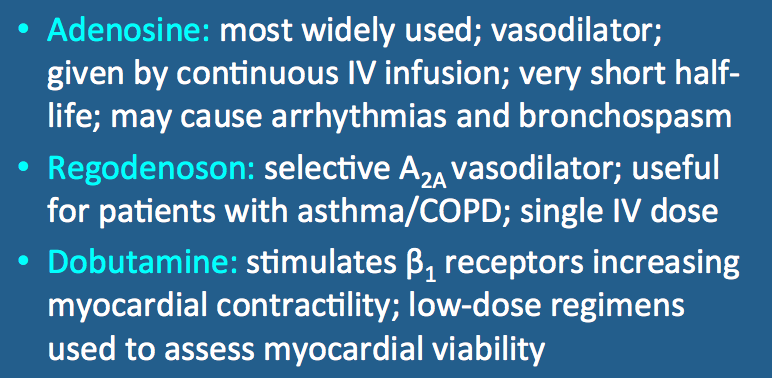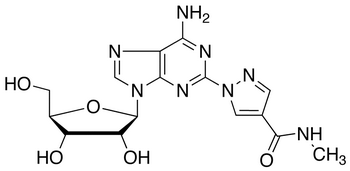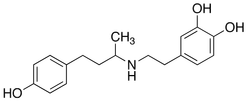|
Adenosine
Adenosine is a potent vasodilator of the coronary and most other vascular beds (except hepatic and renal), acting through nonselective stimulation of A1, A2A, A2B, and A3 receptors. A2A receptors dilate high-resistance myocardial arterioles, allowing stress-induced ischemic regions caused by epicardial coronary artery stenosis to be identified.
|
|
Regadenoson
Regadenoson is a systemic vasodilator with similar structure and function to adenosine. However, regadenoson is a selective A2A receptor agonist, thus avoiding the undesirable negative inotropic (A1) and bronchoconstrictive (A2B and A3) effects of adenosine. It is thus the stress CMR drug of choice for patients with asthma or obstructive airways disease.
|
|
Dobutamine
Dobutamine is a synthetic catecholamine whose primary effect is to stimulate β1 receptors of the sympathetic nervous system. In the heart it produces coronary vasodilatation, increased myocardial contractility (positive inotropic effect), and increased heart rate (positive chronotropic effect).
|
Advanced Discussion (show/hide)»
Dobutamine and vasodilator drugs have different mechanisms of action, and we should not expect the results of CMR stress testing using these different agents to be identical. Adenosine and regadenoson induce blood flow disparities by vasodilation of intracardiac arterioles and shunting. Because the effect of dobutamine is primarily on heart muscle (to increase contractility), it is more likely than vasodilators to elicit wall motion abnormalities as an indicator of inducible ischemia. In certain clinical subgroups dobutatamine-stress CMR has proved more sensitive (but less specific) than vasodilator-stress CMR.
A typical high-dose dobutamine protocol requires 30-40 minutes (versus <10 minutes for an adenosine protocol). It is performed under EKG monitoring as well as continuous viewing of cine MRI loops of wall motion. The goal is to achieve a target heart rate given by the formula
Target HR = 0.85 x (220 − age)
Dobutamine infusion is typically begun by intravenous infusion at a rate of 10 μg/kg/min. Every three minutes the dose is incremented by 10 units (to 20, 30, or 40 μg/kg/min) until the target HR is reached. If still not reached at the 40 level, up to two 0.5 mg doses of intravenous atropine may be administered to reduce vagal tone and increase heart rate. The study is stopped once the target HR is reached, a wall motion abnormality is detected, or serious side effect noted. At this point gadolinium contrast may be administered and a perfusion/enhancement module may be played out to complete the evaluation.
Al Jaroudi W, Iskandrian AE. Regadenoson: a new myocardial stress agent. J Am Coll Cardiol 2009; 54:1123-1130.
Berger A, Fleck E, Gebker R. Update on dobutamine stress magnetic resonance. Curr Cardiovasc Imaging Rep 2012; 5:116-125.
Botvinick EH. Current method of pharmacologic stress testing and the potential advantages of new agents. J Nucl Med Technol 2009; 37;14-25
Charoenpanichkit C, Hundley WG. The 20 year evolution of dobutamine stress cardiovascular magnetic resonance. J Cardiovasc Magn Reson 2010; 12:59.
Geleijnse ML, Krenning BJ, Nemes A, et al. Incidence, pathophysiology, and treatment of complications during dobutamine-atropine stress echocardiography. Circulation 2010; 121:1756-1767.
Hage FG. Regadenoson for myocardial perfusion imaging: Is it safe? J Nucl Cardiol 2014; 21:871-876.
Karamitsos TD, Ntusi NAB, Francis JM, et al. Feasibility and safety of high-dose adenosine perfusion cardiovascular magnetic resonance. J Cardiovasc Magn Reson 2010; 12:66. (Showed that infusion rates of up to 210 can be safely tolerated in patients with inadequate hemodynamic response to standard 140 μg/kg/min dose of adenosine).
Lexiscan® prescribing information (pdf, revised July 2014). See Astrellas Pharma US web site for the most up-to date version.
Paetsch I, Jahnke C, Wahl A, et al. Comparison of dobutamine stress magnetic resonance, adenosine stress magnetic resonance, and adenonsine stress magnetic resonance perfusion. Circulation 2004; 110:835-842. (Shows that wall motion abnormalities seen with dobutamine stress are more sensitive but less specific than adenosine for detection of coronary artery disease.)
Vasu S, Bandettini WP, Hsu L-Y, et al. Regadenoson and adenosine are equivalent vasodilators and are superior than dipyridamole- a study of first pass quantitative perfusion cardiovascular magnetic resonance. J Cardiovasc Magn Reson 2013; 15:85
What risks and complications should patients be informed about when undergoing stress perfusion testing?



